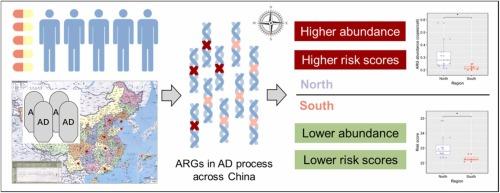中国污泥厌氧消化过程中抗生素耐药基因的地理分布及风险
IF 11.3
1区 环境科学与生态学
Q1 ENGINEERING, ENVIRONMENTAL
引用次数: 0
摘要
厌氧消化(AD)作为抗生素耐药基因(ARGs)的中心储存库越来越受到关注,而ARGs在AD中的地理分布却被忽视。在此基础上,对全中国AD工厂进行了抽样调查,并对其抗性组进行了挖掘。AD污泥中ARGs的丰度为0.198 ~ 0.574拷贝/细胞。在我们的AD系统中检测到一些频繁报告和紧急arg。华南和华北地区ARG丰度和组成均存在显著差异,暗示物理/经济因素可能在ARG剖面的形成中起作用。生活和医院废水中AD样本的风险评分处于中等水平。风险得分在北方明显更高。此外,北部地区一级和二级ARG的比例也较高,这从微观角度解释了ARG组成的区域差异。本研究为中国AD进程中ARG水平和特征的基本调查提供了基础,揭示了ARG的生物地理特征,并为抗生素耐药性的控制策略提供了启示。本文章由计算机程序翻译,如有差异,请以英文原文为准。

Geographical Distribution and Risk of Antibiotic Resistance Genes in Sludge Anaerobic Digestion Process across China
Anaerobic digestion (AD) is gaining increasing attention as the central reservoir of antibiotic resistance genes (ARGs), while the geographical distribution of ARGs in AD is neglected. Accordingly, a sampling scheme on full-scale AD plants across China was implemented, and the resistome therein was excavated. The abundance of ARGs in AD sludge ranged from 0.198 to 0.574 copies/cell. Some of the frequently reported and emergent ARGs were detected in our AD system. Both the abundance and composition of ARGs presented significant differences between the south and north regions of China, hinting the physical/economic factors may function in the formation of ARG profiles. The risk scores of AD samples were in middle of domestic and hospital wastewater. Risk scores were significantly higher in the north. Besides, the proportion of Rank I and Rank II ARGs was also higher in north, which explained the regional difference of ARG composition in a micro-perspective. This study provides a fundamental survey on the of ARG level and profile in AD process across China, reveals the biogeography of ARGs and inspires the control strategies of antibiotic resistance.
求助全文
通过发布文献求助,成功后即可免费获取论文全文。
去求助
来源期刊

Journal of Hazardous Materials
工程技术-工程:环境
CiteScore
25.40
自引率
5.90%
发文量
3059
审稿时长
58 days
期刊介绍:
The Journal of Hazardous Materials serves as a global platform for promoting cutting-edge research in the field of Environmental Science and Engineering. Our publication features a wide range of articles, including full-length research papers, review articles, and perspectives, with the aim of enhancing our understanding of the dangers and risks associated with various materials concerning public health and the environment. It is important to note that the term "environmental contaminants" refers specifically to substances that pose hazardous effects through contamination, while excluding those that do not have such impacts on the environment or human health. Moreover, we emphasize the distinction between wastes and hazardous materials in order to provide further clarity on the scope of the journal. We have a keen interest in exploring specific compounds and microbial agents that have adverse effects on the environment.
 求助内容:
求助内容: 应助结果提醒方式:
应助结果提醒方式:


